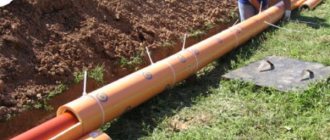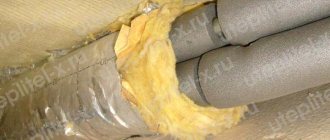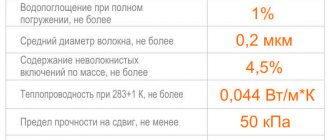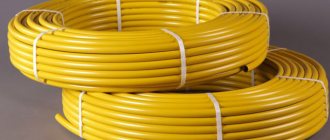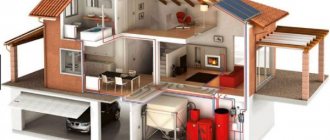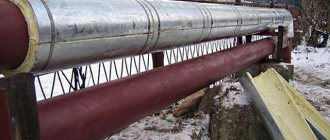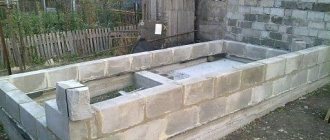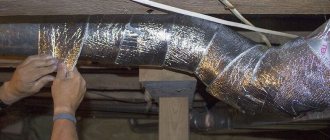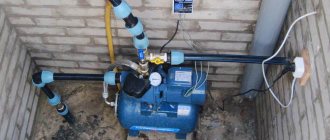Automated calculation of the volume of insulation of round surfaces, such as pipes, air ducts and pipelines, by outer diameter. The calculator calculates the volume of insulation in cubic meters, as well as the insulation area in square meters. According to the technical part of the collection FER26:2. Rules for calculating the volume of work 2.1 The volume of insulation “in use” (Oi) m3 per 1 m of length of pipelines or cylindrical equipment is calculated using the formula: Oi = 3.14 × (D + T) × T, where T is the thickness of the insulating layer, m; D - outer diameter of the pipeline or equipment, m.2.2. Length of insulated pipelines, as well as equipment of cylindrical and rectangular sections, etc.
determined along the center line for each section, and fittings and flanges, fittings, etc. are not excluded from the length.2.3. The perimeter of a polygonal and similar section is determined as the arithmetic mean of the perimeters of the internal and external surfaces of the insulation.2.4. The volume of insulation of individual places near instrumentation and fittings, as well as near all kinds of hatches, fittings, openings on equipment is taken into account in prices, while the length of insulated pipelines is measured without deducting the indicated places.
To get the result, enter values in the form fields.
Did you like the calculator? Share with your friends
Find the angle ABC of an isosceles trapezoid ABCD if the diagonal AC forms with the base AD and * Trapezium Mathematics / Russian language 9th grade.
Calculation of insulation volume, area of anti-corrosion coating and covering material
Calculation of the volume of insulation, the area of covering material and anti-corrosion coating often has to be done when drawing up estimates and closing completed volumes. We are all used to using reference books or a calculator to calculate actual volumes, but if it can be automated, then let's use this opportunity.
To calculate the volume of insulation and the area of covering material, select the type of surface to be insulated and enter the values in the appropriate fields.
Database
The program has its own database of insulating materials. This database is open and flexible in its structure - it allows you to view data on materials and edit them using a convenient database editor. The database includes both basic and auxiliary materials, as well as their properties, main manufacturers and the sizes they produce. We are open to cooperation with all manufacturers of materials (supplying high-quality and certified products) to replenish the database with their materials.
Calculation of insulation volume, area of anti-corrosion coating and covering material
Calculation of the volume of insulation, the area of covering material and anti-corrosion coating often has to be done when drawing up estimates and closing completed volumes. We are all used to using reference books or a calculator to calculate actual volumes, but if it can be automated, then let's use this opportunity.
To calculate the volume of insulation and the area of covering material, select the type of surface to be insulated and enter the values in the appropriate fields.
Interface
Program dialog box
Material Database Editor Window
“Conditions of applicability of materials” window for setting up rules for selecting materials
Working window of the built-in module “Construction Climatology”, corresponding to SP 131.13330.2018 “SNiP 23-01-99* Construction Climatology”
Automatically generated material applicability diagram
Calculation of the volume of pipeline insulation and laying of material
- Types of insulation materials Laying insulation Calculation of pipeline insulation materials Elimination of insulation defects
Insulation of pipelines is necessary in order to significantly reduce heat loss.
First you need to calculate the volume of pipeline insulation. This will not only optimize costs, but also ensure competent execution of work and maintenance of pipes in proper condition. The right material can prevent corrosion and improve thermal insulation.
Pipe insulation diagram.
Today, different types of coatings can be used to protect highways. But it is necessary to consider exactly how and where communications will take place.
For water pipes, two types of protection can be used at once - internal coating and external. It is recommended to use mineral wool or glass wool for heating routes, and to purchase polyurethane foam for industrial ones. Calculations are performed using different methods, it all depends on the type of coating chosen.
Integration
The program provides the ability to import data from projects in the Hydrosystem program, from the DBMS-project system, from open format files, as well as from the PDMS system (via open format files).
After calculation, the program allows you to print various types of output documents:
general data sheet;
technical installation sheet for the construction department;
statement of quantities for the estimate department;
specification to the material support department in accordance with GOST 21.405-93, GOST 21.110-2013 and GOST R 21.1101-2013;
task for calculating electrical heating systems.
The structure of the program's output information has an open format, and it is possible to connect it to the document flow system available at the enterprise. Documentation complies with SPDS. The type of output documents can be customized to your liking.
Types of insulating materials
Various materials are used to insulate pipelines. They differ in the type of application, layer thickness and their characteristics.
The choice should be taken carefully. Bituminous coatings were considered the most popular not so long ago. In some cases, the pipe can be additionally protected by fiberglass.
Bituminous materials are used for thermal insulation of underground lines. They prevent corrosion. Operating conditions are as follows: for normal outdoor installation -40/+65°C, for deep underground use -5/+30°C.
Copper and steel pipe insulation chart.
To save money, polymer-bitumen compositions can be used. Installation is quick, and the quality of pipeline insulation is high. PPU is a reliable and durable material that can be used during channelless or channel installation of communications, for overhead pipelines.
The result is a “pipe-in-pipe” gasket. The work process is simple, even a beginner can handle it. Polyurethane foam is applied in liquid form to the surface, after which it hardens, forming a durable and strong shell.
Anti-corrosion polyethylene insulation is a multi-layer coating that is applied only in industrial conditions.
Such pipes are used for transporting petroleum products and gas mixtures. Glass wool is also often used today. This is a simple and reliable material that is easy to apply.
Calculating the area is carried out without any particular difficulties, but it is necessary to take into account the thickness of the layer. Mineral wool is also great for heating pipes. The material can be used to insulate pipes of different diameters.
Choosing insulation
The main reason for pipeline freezing is insufficient energy circulation speed.
In this case, at sub-zero air temperatures, the process of crystallization of the liquid may begin. So high-quality thermal insulation of pipes is vital. Fortunately, our generation is incredibly lucky. In the recent past, insulation of pipelines was carried out using only one technology, since there was only one insulation - glass wool. Modern manufacturers of thermal insulation materials simply offer the widest selection of pipe insulation materials, differing in composition, characteristics and method of application.
It is not entirely correct to compare them with each other, much less to say that one of them is the best. So let's just look at the types of pipe insulation materials.
By scope:
- for cold and hot water supply pipelines, steam pipelines for central heating systems, various technical equipment;
- for sewer and drainage systems;
- for pipes of ventilation systems and freezing equipment.
In appearance, which, in principle, immediately explains the technology for using insulation:
- roll;
- leafy;
- casing;
- filling;
- combined (this rather refers to the method of pipeline insulation).
The main requirements for the materials from which pipe insulation is made are low thermal conductivity and good fire resistance.
The following materials meet these important criteria:
Mineral wool. Most often sold in roll form. Suitable for insulating pipelines with high temperature coolant. However, if you use mineral wool to insulate pipes in large volumes, then this option will not be very profitable in terms of economy. Thermal insulation using mineral wool is produced by the winding method, followed by its fastening with synthetic twine or stainless wire.
The photo shows a pipeline insulated with mineral wool
It can be used at both low and high temperatures. Suitable for steel, metal-plastic and other polymer pipes. Another positive feature is that polystyrene foam has a cylindrical shape, and its internal diameter can be adjusted to the size of any pipe.
Penoizol. According to its characteristics, it is closely related to the previous material. However, the method of installing penoizol is completely different - its application requires a special spraying installation, since it is a component liquid mixture. After the penoizol hardens, a sealed shell is formed around the pipe, almost impervious to heat. Another advantage here is the lack of additional fastening.
Penoizol in action
Foiled penofol. The latest development in the field of insulation materials, but it has already won its fans among Russian citizens. Penofol consists of polished aluminum foil and a layer of foamed polyethylene.
This two-layer design not only retains heat, but even acts as a kind of heater! As you know, foil has heat-reflecting properties, which allows it to accumulate and reflect heat to the insulated surface (in our case, a pipeline).
In addition, foil penofol is environmentally friendly, low-flammable, resistant to temperature changes and high humidity.
As you can see, there are plenty of materials! There is plenty to choose from to insulate pipes. But when choosing, do not forget to take into account the characteristics of the environment, the characteristics of the insulation and its ease of installation. Well, it wouldn’t hurt to calculate the thermal insulation of the pipes in order to do everything correctly and reliably.
Laying insulation
The calculation of insulation depends on what kind of installation is used. It can be external or internal.
External insulation is recommended for the protection of heating systems. It is applied along the outer diameter and provides protection against heat loss and the appearance of traces of corrosion. To determine the volume of material, it is enough to calculate the surface area of the pipe.
Thermal insulation maintains the temperature in the pipeline regardless of the influence of environmental conditions.
Internal laying is used for plumbing.
It perfectly protects against chemical corrosion and prevents heat loss through hot water routes. Usually this is a coating material in the form of varnishes and special cement-sand mortars. The choice of material can also be made depending on what kind of gasket will be used.
Channel laying is most often in demand. For this purpose, special channels are preliminarily arranged, and the routes are placed in them. The channelless installation method is used less frequently, since the work requires special equipment and experience. The method is used in cases where it is not possible to carry out trenching work.
Methodology for calculating a single-layer thermal insulation structure
The basic formula for calculating the thermal insulation of pipelines shows the relationship between the amount of heat flow from an existing pipe covered with a layer of insulation and its thickness. The formula applies if the pipe diameter is less than 2 m:
Formula for calculating thermal insulation of pipes.
ln B = 2πλ [K(tт - to) / qL - Rн]
In this formula:
- λ — thermal conductivity coefficient of insulation, W/(m ⁰C);
- K is the dimensionless coefficient of additional heat loss through fasteners or supports, some values of K can be taken from Table 1;
- tt is the temperature in degrees of the transported medium or coolant;
- to—outside air temperature, ⁰C;
- qL—heat flow value, W/m2;
- Rн - heat transfer resistance on the outer surface of the insulation, (m2 ⁰C) / W.
Table 1
| Pipe laying conditions | K coefficient value |
| Steel pipelines are open along the street, through channels, tunnels, open indoors on sliding supports with a nominal diameter of up to 150 mm. | 1.2 |
| Steel pipelines are open along the street, through channels, tunnels, open indoors on sliding supports with a nominal diameter of 150 mm or more. | 1.15 |
| Steel pipelines are open along the street, through canals, tunnels, and open indoors on suspended supports. | 1.05 |
| Non-metallic pipelines laid on suspended or sliding supports. | 1.7 |
| Channelless installation method. | 1.15 |
The thermal conductivity value of the insulation λ is a reference value, depending on the selected thermal insulation material. It is recommended to take the temperature of the transported medium tt as the average throughout the year, and the temperature of the outside air tto as the average annual temperature. If the insulated pipeline runs indoors, then the ambient temperature is set by the technical specifications for the design, and in its absence it is taken equal to +20°C. The indicator of heat transfer resistance on the surface of a heat-insulating structure Rн for outdoor installation conditions can be taken from Table 2.
table 2
| Rн,(m2 ⁰C) /W | DN32 | DN40 | DN50 | DN100 | DN125 | DN150 | DN200 | DN250 | DN300 | DN350 | DN400 | DN500 | DN600 | DN700 |
| tt = 100 ⁰C | 0.12 | 0.10 | 0.09 | 0.07 | 0.05 | 0.05 | 0.04 | 0.03 | 0.03 | 0.03 | 0.02 | 0.02 | 0.017 | 0.015 |
| tt = 300 ⁰C | 0.09 | 0.07 | 0.06 | 0.05 | 0.04 | 0.04 | 0.03 | 0.03 | 0.02 | 0.02 | 0.02 | 0.02 | 0.015 | 0.013 |
| tt = 500 ⁰C | 0.07 | 0.05 | 0.04 | 0.04 | 0.03 | 0.03 | 0.03 | 0.02 | 0.02 | 0.02 | 0.02 | 0.016 | 0.014 | 0.012 |
Note: the value of Rн at intermediate values of coolant temperature is calculated by interpolation. If the temperature is below 100 ⁰C, the value of Rн is taken as for 100 ⁰C.
Indicator B should be calculated separately:
Table of heat losses for different pipe thicknesses and thermal insulation.
B = (diz + 2δ) / dtr, here:
- diz - outer diameter of the heat-insulating structure, m;
- dtr — outer diameter of the protected pipe, m;
- δ—thickness of the thermal insulation structure, m.
Calculation of the thickness of pipeline insulation begins with determining the indicator ln B, substituting into the formula the values of the outer diameters of the pipe and thermal insulation structure, as well as the thickness of the layer, after which the parameter ln B is found using the table of natural logarithms. It is substituted into the main formula along with the indicator of the normalized heat flow qL and make a calculation. That is, the thickness of the pipeline insulation must be such that the right and left sides of the equation become identical. This thickness value should be taken for further development.
The considered calculation method applied to pipelines with a diameter of less than 2 m. For pipes of larger diameter, the calculation of insulation is somewhat simpler and is carried out both for a flat surface and using a different formula:
δ = [K(tт - to) / qF - Rн]
In this formula:
- δ—thickness of the thermal insulation structure, m;
- qF is the value of the normalized heat flow, W/m2;
- other parameters are the same as in the calculation formula for a cylindrical surface.
Calculation of pipeline insulation materials
It is not difficult to carry out insulation calculations for pipelines; for convenience, it is recommended to use special calculators.
There are a number of actions that allow you to preliminarily determine the volume of materials. Before starting calculations, you should immediately decide what type of insulation will be used. Insulators differ not only in appearance, but also in installation conditions and properties.
Painting agents can be used to insulate pipelines.
The quality of the materials is high, the layer is thin but durable, fully performing all functions. The calculation is done as follows:
The formula for calculating the area of the cylinder is S=2πr(h+r), where r is the radius of the base of the pipe, h is the pipe length parameter, π is a constant, the approximate value for this case is 3.14. The resulting value is the coloring area. Next, according to the manufacturer’s instructions, determine the material consumption.
Scheme for calculating thermal insulation for a pipe.
When using conventional insulating materials, calculations are much simpler. It is necessary to determine the volume for the inside and outside of the pipe. To do this, use the formula V=πr2h, where:
- V – pipeline volume; r – radius value (external or internal); h – pipe length; π is equal to 3.14.
The value of the internal and external radius is calculated separately, the resulting difference will be equal to the volume of the entire pipeline insulation material. Wrapping is an option for external insulation. In this case, the calculation is performed similarly using the first formula indicated, but it is necessary to take into account the thickness of the material, since it affects the quantity.
Video
Recommendations for professional construction
Life hacks for private housing construction
Protect yourself from noise, recommendations for installing sound insulation
Marine insulation SeaRox
Secrets of building energy efficient houses
7 benefits of stone, a series of exciting experiments
Technologies
Double Density
The company's patented solution
Compression
Vacuum compression packaging allows you to transport three times more material
Flexi edge
The springy edge of the slab ensures precise and reliable fixation of the insulation in the frame
Winding cylinders
Advantages of products of the wound production method over the cut-out method
Power+
International development of ROCKWOOL is now in Russia
Power+ Acoustics
The second stage of technological modernization - acoustic solutions
Prevent corrosion
How to combat the most costly problem facing the industry.
Single-layer insulation
Research by NIIMosstroy has proven the effectiveness of single-layer insulation
Elimination of insulation defects
Over time, repairs will be required to insulate the pipeline.
Of course, proper operation allows you to extend the service life of not only the pipes, but also the finishing. Periodically it is necessary to carry out an inspection, and then carry out partial repairs so as not to lead to a major one, i.e.
replacing the insulation layer itself or, in the worst case, pipes. How to avoid repairs? It is necessary to install special sensors that monitor the state of the system.
The repair itself may consist of the following actions:
The condition of the insulation surface should be inspected regularly. If there is damage, then it is necessary to patch the defective area and inspect the surface of the pipe.
Further repairs depend on the condition of the pipes. Usually you just need to clean off traces of corrosion, but in more complex cases, individual sections need to be replaced. A new layer of pipeline insulation is then applied.
When repairing the coating, you should choose the same material that was used before. If for some reason it does not meet the requirements, then the entire insulation should be replaced so that there is no heat loss and no areas susceptible to corrosion arise.
Various materials can be used to insulate pipes and protect them from corrosion. Before purchasing them, you should choose the right coating.
Anton Mikhailovich Dergachev
No problem. We take the perf and perforate)
Interesting info, I didn’t know that it was necessary to reinforce foam and gas blocks
I'll add it to my bookmarks. I’m just planning to install a frame.
Lately, I’ve been thinking more and more often about building a house, and I find a lot of similar useful articles. I will definitely do a vapor barrier, especially since Va.
Thank you. Very detailed and understandable, and in my case, relevant.
We offer you a calculator for automated calculation of the volume of insulation for pipelines for various purposes - sewerage, air ducts, heating or gas pipelines. We recommend that you read the instructions first.
In the conditions of our country with its vast expanses, pipeline transport is the most effective means of transporting liquid products. The dimensions of the pipes reach three meters in diameter, which makes it possible to transport large volumes of products through them. Naturally, such highways require certain protection from various factors:
- corrosion of all types; freezing; physical impact of natural phenomena; from unauthorized intervention by unauthorized persons.
All highways, including gas and oil pipelines, not to mention water systems, are subject to insulation for operation in the temperature range of -45 + 60 degrees. Mass application of such a technological operation requires careful calculation of the need for materials for covering the surface of pipes, so that the costs for it are optimal; calculating the insulation of pipelines using various calculators is a necessity.
Configuration
Description of options
The following modules are supplied with the program:
- STARS library
Designed for calculating the thermophysical properties of transported products for those calculation criteria for which they are necessary
- Based on the data of SP 131.13330.2018 “SNiP 23-01-99* Construction climatology” allows you to determine the climatic parameters of the settlement where the object is located
- Which declines the texts of the names of materials and isolated objects for output documents
Insulation materials
The range of means for installing insulation is very extensive.
Their difference lies both in the method of application on the surface and in the thickness of the thermal insulation layer. The application features of each type are taken into account by calculators for calculating pipeline insulation. The use of various bitumen-based materials with the use of additional reinforcing products, such as fiberglass or fiberglass, is still relevant.
Polymer-bitumen compositions are more economical and durable.
They allow for quick installation and the quality of the coating is durable and effective. The material, called polyurethane foam, is reliable and durable, which allows its use for both channel and non-channel methods of laying highways. Liquid polyurethane foam is also used, applied to the surface during installation, as well as other materials:
- polyethylene as a multilayer shell, applied in industrial production for waterproofing; glass wool of various thicknesses, an effective insulation due to its low cost with sufficient strength; for heating mains, mineral wool of the calculated thickness is effectively used to insulate pipes of various diameters.
Method for determining the surface temperature of an insulating layer based on a given temperature
This requirement is relevant in industrial enterprises where various pipelines run inside rooms and workshops where people work. In this case, the temperature of any heated surface is normalized in accordance with labor protection rules in order to avoid burns. Calculation of the thickness of the thermal insulation structure for pipes with a diameter over 2 m is carried out in accordance with the formula:
Formula for determining the thickness of thermal insulation.
δ = λ (tt - tp) / ɑ (tp - t0), here:
- ɑ — heat transfer coefficient, taken from reference tables, W/(m2 ⁰C);
- tп – normalized temperature of the surface of the heat-insulating layer, ⁰C;
- other parameters are as in the previous formulas.
The thickness of the insulation on a cylindrical surface is calculated using the equation:
ln B =(diz + 2δ) / dtr = 2πλ Rн (tt - tp) / (tp - t0)
Designations of all parameters are as in the previous formulas. According to the algorithm, this calculation is similar to calculating the thickness of insulation based on a given heat flow. Therefore, it is then carried out in exactly the same way; the final value of the thickness of the heat-insulating layer δ is found as follows:
δ = diz (B - 1) / 2
The proposed method has some error, although it is quite acceptable for preliminary determination of the parameters of the insulating layer. A more accurate calculation is performed by the method of successive approximations using a personal computer and specialized software.
Installation of insulation
Calculation of the amount of insulation largely depends on the method of its application. It depends on the place of application - for the internal or external insulating layer.
You can do it yourself or use a calculator program to calculate the thermal insulation of pipelines. Coating on the outer surface is used for water pipelines for hot water supply at high temperatures to protect it from corrosion. Calculation with this method comes down to determining the area of the outer surface of the water supply system to determine the need per linear meter of pipe.
Internal insulation is used for water main pipes. Its main purpose is to protect metal from corrosion. It is used in the form of special varnishes or a cement-sand composition with a layer several mm thick.
The choice of material depends on the installation method - channel or non-channel. In the first case, concrete trays are placed at the bottom of an open trench for placement. The resulting gutters are closed with concrete lids, after which the channel is filled with previously excavated soil.
Ductless installation is used when digging a heating main is not possible.
This requires special engineering equipment. Calculating the volume of thermal insulation of pipelines in online calculators is a fairly accurate tool that allows you to calculate the amount of materials without fiddling with complex formulas. Material consumption rates are given in the relevant SNiP.
Related posts:
Published: December 29, 2017
( 4 ratings, average: 5.00 out of 5)Loading…
- Date: 04/15/2015 Comments: Rating: 26
Correctly calculated pipeline thermal insulation can significantly increase the service life of pipes and reduce their heat loss. However, in order not to make mistakes in the calculations, it is important to take into account even minor nuances.
Thermal insulation of pipelines prevents the formation of condensate, reduces the heat exchange of pipes with the environment, and ensures the operability of communications.
Working with an online calculator
To calculate the thickness of pipeline insulation, enter the following initial data into the calculator fields:
- Outer diameter of the pipeline (in mm).
- Insulation material. Typically the field looks like a drop-down list where you can select the appropriate option. Some calculators are more specific, and are designed for only one heat insulator (for example, a mineral wool cylinder).
- Average coolant temperature. The indicator may include two numbers (readings in the forward/return pipeline), for example, 65/50, 90/50, 110/50.
- Temperature of the insulated surface (in °C).
Insulation of underground communications Source znatoktepla.ru
- Type of protective coating, metallic or non-metallic.
- Time until water freezes when the system is stopped: 0.5 hours, 0.75 hours, 1 hour, 1.25 hours.
To calculate the volume of thermal insulation of pipelines, additional parameters are entered into the calculator:
- Insulation thickness (in mm).
- Pipeline length (in m).
- The material from which the pipe is made (plastic or metal).
- The specific gravity (density) of the insulation, its thermal conductivity coefficient (sometimes it is enough to select a name from the list).
Some insulation calculators allow you to calculate the amount of thermal insulation for round bends. In this case, it is necessary to specify the bending radius (curvature of the center line) and the number of bends.
As a result, you will get the thickness or volume of thermal insulation suitable for your conditions. For any parameters, it is not recommended to purchase thermal insulation of greater thickness, “with a margin”. Such a modification will not bring a fundamental improvement, but the increase in the cost of the material, compared to insignificant optimization, will be significant.
Pipeline insulation on the street Source pinimg.com
